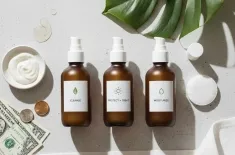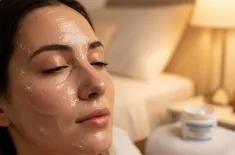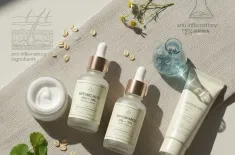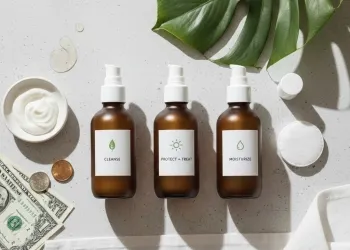Discover how the Microbiome Diet leverages the gut-skin axis with fermented foods
The human body is home to trillions of microorganisms—bacteria, fungi, and viruses—collectively known as the microbiome. The gut harbors the largest and most diverse community, while the skin also maintains its own unique **skin microbiome**, a crucial first line of defense against the external world.
Understanding the Gut-Skin Axis: The Internal Link to Skin Health
The **gut-skin axis** is the scientific term for the constant communication loop between the gut and the skin, mediated by the immune system, nervous system, and circulating metabolites (byproducts of digestion). When the gut microbiome is in a state of imbalance, known as dysbiosis, the consequences often manifest on the skin.
Dysbiosis and Skin Conditions
An unhealthy gut lining, often caused by a diet high in processed foods, sugar, and unhealthy fats, can become permeable—a condition sometimes referred to as "leaky gut." This allows undigested food particles, toxins, and inflammatory molecules to enter the bloodstream. The body's immune system, which is largely housed in the gut, recognizes these substances as threats and mounts a systemic inflammatory response.
This inflammation travels through the bloodstream and can trigger or exacerbate various skin conditions, including:
- Acne: Gut dysbiosis can increase systemic inflammation and hormone-like substances (such as IGF-1) which stimulate sebum production and contribute to the proliferation of C. acnes bacteria.
- Eczema (Atopic Dermatitis): People with eczema often exhibit reduced microbial diversity in both the gut and the skin, coupled with a weakened **barrier function**. Inflammation from the gut can further compromise the skin barrier, leading to dryness, irritation, and flares.
- Redness and Rosacea: Imbalances in the gut, particularly an overgrowth of certain bacteria like in Small Intestinal Bacterial Overgrowth (SIBO), have been strongly linked to rosacea symptoms like facial flushing and inflammation.
By prioritizing a diet that supports the gut, the Microbiome Diet aims to reduce this systemic inflammation, thereby calming the immune response that drives these chronic skin issues.
The Microbiome Diet: Fueling Your Healthy Bacteria
The Microbiome Diet is fundamentally a high-fiber, nutrient-dense eating plan designed to eliminate foods that disrupt the gut lining and introduce an abundance of foods that nourish a diverse and robust microbial community. The core components of this diet are focused on repopulating the gut with **healthy bacteria** and providing them with the necessary fuel to thrive.
The Power of Probiotics: Live Microbes for Skin Health
**Probiotics** are live microorganisms, typically bacteria and yeasts, that, when consumed in adequate amounts, confer a health benefit on the host. These are the front-line soldiers in restoring balance to the gut.
How Probiotics Influence Skin Health:
- Anti-Inflammatory Action: Probiotic strains like Lactobacillus and Bifidobacterium can help modulate the immune system, reducing the overall inflammatory signals that trigger acne, eczema, and redness.
- Strengthening the Gut Barrier: They reinforce the tight junctions of the intestinal lining, helping to prevent "leaky gut" and the subsequent release of inflammatory toxins into the bloodstream.
- Producing Beneficial Metabolites: Probiotics ferment dietary fiber into short-chain fatty acids (SCFAs), such as butyrate. SCFAs are vital for maintaining the health and integrity of both the gut lining and the skin **barrier function**.
Fermented Foods: Ancient Wisdom, Modern Glow
**Fermented foods** are a cornerstone of the Microbiome Diet, acting as natural sources of diverse probiotics. The fermentation process not only introduces live cultures but also breaks down food components into more easily digestible and bioavailable nutrients.
| Fermented Food | Key Benefits for Skin |
|---|---|
| Kefir & Yogurt (with live cultures) | High in protein, calcium, and diverse probiotic strains; studies suggest they may reduce skin dryness. |
| Sauerkraut & Kimchi | Excellent sources of Lactobacillus and prebiotics; rich in vitamins (like Vitamin C and K) and antioxidants. |
| Kombucha | Fermented tea containing a mix of bacteria and yeast (SCOBY); rich in B vitamins and organic acids that support skin clarity. |
| Miso & Tempeh | Fermented soy products that are sources of protein and isoflavones, which can offer antioxidant benefits. |
Regular consumption of these foods is a direct and enjoyable way to introduce a wide variety of **healthy bacteria** into the gut, significantly contributing to the **holistic beauty** approach by improving the skin from the inside out.
Prebiotics: The Food for Good Bacteria
While probiotics introduce **healthy bacteria**, **prebiotics** are the non-digestible fibers that serve as food for the existing beneficial microbes in the gut. A diet rich in prebiotics ensures that the probiotic and native **healthy bacteria** populations are well-fed and thriving.
Excellent prebiotic sources include:
- Vegetables: Garlic, onions, leeks, asparagus, artichokes.
- Fruits: Bananas, apples, berries.
- Whole Grains & Legumes: Oats, barley, chickpeas, lentils.
By increasing prebiotic fiber, the Microbiome Diet promotes the natural production of beneficial SCFAs, which directly support the skin's defense mechanisms.
Beyond Diet: Probiotic Skincare and Barrier Function
While internal support is paramount, the external layer of the **skin microbiome** also plays a critical role in skin health. The skin’s **barrier function**—its outermost layer—is regulated by the microbial community living on it. This barrier prevents moisture loss and shields the skin from pathogens, UV damage, and environmental pollutants.
Topical Support: Probiotic Skincare
**Probiotic skincare** products are designed to support the native **skin microbiome** by introducing beneficial bacterial strains or their byproducts (postbiotics) directly onto the skin.
- Topical Probiotics: Can help rebalance the surface ecosystem, outcompeting harmful bacteria and reducing the skin's inflammatory response. Research shows that certain topical probiotics can even inhibit the growth of P. acnes, the bacteria linked to acne.
- Postbiotics (Fermented Ingredients): Often derived from the fermentation process, ingredients like fermented rice extract, yeast extract, and lactic acid are rich in beneficial compounds. These smaller molecules are easily absorbed and have been shown to boost ceramide production (essential for the **barrier function**), reduce redness, and enhance hydration.
Combining the internal approach of the Microbiome Diet with the external use of **probiotic skincare** creates a synergistic effect, treating the skin with a complete, 360-degree approach to **holistic beauty**.
Conclusion: The Path to Radiance
Achieving truly glowing skin is a journey that begins not in the beauty aisle, but at the dinner table. The Microbiome Diet offers a powerful, science-backed framework for cultivating **holistic beauty** by recognizing the profound connection of the **gut-skin axis**.
By consistently making **dietary choices** rich in prebiotic fiber and **fermented foods** (natural sources of **healthy bacteria**), you directly nourish your internal ecosystem. This, in turn, strengthens your intestinal barrier, reduces systemic inflammation, and fortifies the skin's **barrier function**. The reduction in inflammatory signals is the mechanism by which this diet helps to significantly reduce common skin conditions like **acne, eczema, and redness**, restoring balance and allowing your skin’s natural, healthy radiance to shine through. The integration of targeted **probiotic skincare** can further support this inner transformation, resulting in resilient, balanced, and vibrant skin that reflects true health from the inside out.



































